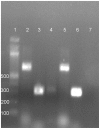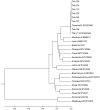Isolation of Tacaribe virus, a Caribbean arenavirus, from host-seeking Amblyomma americanum ticks in Florida
- PMID: 25536075
- PMCID: PMC4275251
- DOI: 10.1371/journal.pone.0115769
Isolation of Tacaribe virus, a Caribbean arenavirus, from host-seeking Amblyomma americanum ticks in Florida
Abstract
Arenaviridae are a family of single stranded RNA viruses of mammals and boid snakes. Twenty-nine distinct mammalian arenaviruses have been identified, many of which cause severe hemorrhagic disease in humans, particularly in parts of sub-Saharan Africa, and in Central and South America. Humans typically become infected with an arenavirus through contact with excreta from infected rodents. Tacaribe virus (TCRV) is an arenavirus that was first isolated from bats and mosquitoes during a rabies surveillance survey conducted in Trinidad from 1956 to 1958. Tacaribe virus is unusual because it has never been associated with a rodent host and since that one time isolation, the virus has not been isolated from any vertebrate or invertebrate hosts. We report the re-isolation of the virus from a pool of 100 host-seeking Amblyomma americanum (lone star ticks) collected in a Florida state park in 2012. TCRV was isolated in two cell lines and its complete genome was sequenced. The tick-derived isolate is nearly identical to the only remaining isolate from Trinidad (TRVL-11573), with 99.6% nucleotide identity across the genome. A quantitative RT-PCR assay was developed to test for viral RNA in host-seeking ticks collected from 3 Florida state parks. Virus RNA was detected in 56/500 (11.2%) of surveyed ticks. As this virus was isolated from ticks that parasitize humans, the ability of the tick to transmit the virus to people should be evaluated. Furthermore, reservoir hosts for the virus need to be identified in order to develop risk assessment models of human infection.
Conflict of interest statement
Figures





References
-
- Harmon B, Kozina C, Maar D, Carpenter TS, Branda CS, et al. (2013) Identification of critical amino acids within the nucleoprotein of Tacaribe virus important for anti-interferon activity. J Biol Chem 288:8702–8711 Available: http://www.jbc.org/content/288/12/8702.full. Accessed 2013 May 24 - PMC - PubMed
-
- Charrel RN, de Lamballerie X (2010) Zoonotic aspects of arenavirus infections. Vet Microbiol 140:213–220 Available: http://www.ncbi.nlm.nih.gov/pubmed/19748747. Accessed 2014 May 23 - PubMed
-
- Mills JN, Ellis BA, McKee KT, Calderon GE, Maiztegui JI, et al. (1992) A longitudinal study of Junin virus activity in the rodent reservoir of Argentine hemorrhagic fever. Am J Trop Med Hyg 47:749–763 Available: http://www.ncbi.nlm.nih.gov/pubmed/1335214. Accessed 2013 Jul 8 - PubMed
-
- Bowen MD, Peters CJ, Nichol ST (1997) Phylogenetic analysis of the Arenaviridae: patterns of virus evolution and evidence for cospeciation between arenaviruses and their rodent hosts. Mol Phylogenet Evol 8:301–316 Available: http://dx.doi.org/10.1006/mpev.1997.0436. Accessed 2012 Nov 6 - DOI - PubMed
-
- Bowen MD, Peters CJ, Nichol ST (1996) The phylogeny of New World (Tacaribe complex) arenaviruses. Virology 219:285–290 Available: http://dx.doi.org/10.1006/viro.1996.0248. Accessed 2012 NOv 1 - DOI - PubMed
Publication types
MeSH terms
Substances
LinkOut - more resources
Full Text Sources
Other Literature Sources
Molecular Biology Databases
Research Materials

